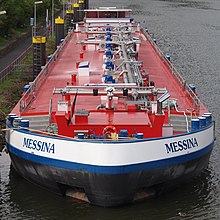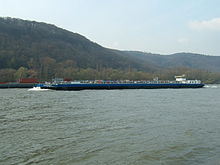Motor tanker
A motor tanker is in the inland waterways in freight employed cargo vessel for the carriage of liquids or gases in fixed tanks, insofar as it has its own drive. Inland tankers are built differently depending on their purpose. The classification is based on the type of construction in N, C and G.

construction
The tankers can be single-hulled or double-hulled and are suitable for the transport of oil products, acids and alkalis . In terms of design, a distinction is made between smooth-deckers and ships with a trunk deck , with the hull simultaneously forming the tanks or tanks being used in the hull. The number of tanks varies depending on the size of the ship. A 110-meter ship for mineral oil products usually has 14 cargo tanks located on the port and starboard side. Each tank is connected to a common loading and unloading line, as well as to a common gas displacement line. With this line, the gases that form in the tanks are discharged to the outside via a high-speed valve at a certain pressure. When charging, the gas displacement line is connected to the shore-side charging device. On-board pumps are available for loading and unloading, and these are driven either directly by a diesel, electric or hydraulic motor. Ships that mainly transport heavy oil products are equipped with heating coils in the cargo tanks. The heating can be done with an on-board boiler while driving or in the port of discharge via a steam pipe from land. On some ships, the tanks are coated on the inside. This reduces the usually very time-consuming cleaning work during load changes. The maximum tank size is 380 m³. Tankers that transport acids or alkalis have used steel or stainless steel tanks. In order to be as flexible as possible, each tank has its own extinguishing pump. These ships can be easily recognized by a very complex pipeline system on deck.
Type N
The type N tankers are divided into three groups depending on the dangerousness of the goods to be transported.
- Closed for products with a low flash point (gasoline)
- Open with flame arrester for products that are too dangerous to be transported in an open ship
- Open to dangerous goods of the lowest level such as diesel fuel , tar , non-toxic acids and alkalis and food oils. Open means that the cargo tank can freely exchange air and gases with the environment.
Type c
Type C tankers are designed for the transport of toxic and particularly dangerous chemicals and oil products. These ships are designed as double hull ships and are only built as smooth deckers. Ships with inserted tanks can be recognized by the external reinforcements of the deck. Tanks are often installed without a longitudinal center bulkhead and each tank has its own extinguishing pump. So you can transport several different products at the same time. Ships that are equipped with Scheldehuid side walls are not subject to the size restriction of 380 m³ per tank.
Type G
The type G tankers are gas tankers. These ships can be built as single or double hulled ships. The gas is transported in cylindrical pressure tanks.
Safety devices
On each tank there is a pressure gauge that shows the internal pressure in the tank, a display for the filling level in the tank and an air intake device with a flame screen. Depending on the loaded product, tankers do not have to have one, one or two blue cones during the day and a corresponding number of blue lights at night.
Special tankers
A special form of tanker are ships for the transport of powdery goods such as cement , flour or sugar .
Individual evidence
- ↑ REGULATION (EC) No. 425/2007 OF THE COMMISSION of April 19, 2007 implementing Regulation (EC) No. 1365/2006 (PDF) of the European Parliament and of the Council on the statistics of freight transport on inland waterways. Ship types see Annex II Section II, page 11 of the PDF file (80 KB)
- ↑ http://www.ccr-zkr.org/files/conventions/adn/ADN_2011de.pdf Chap. 9.3 Building regulations for inland tankers
Web links
- Germanischer Lloyd: Information on shipbuilding (PDF; 1.7 MB)



